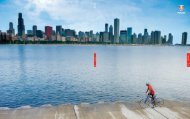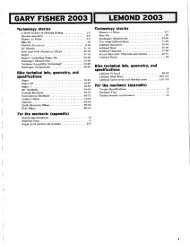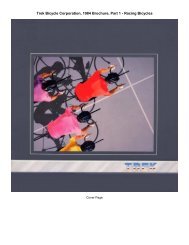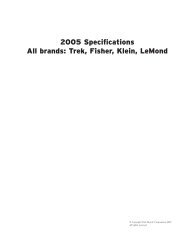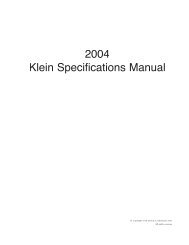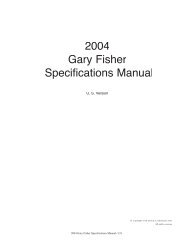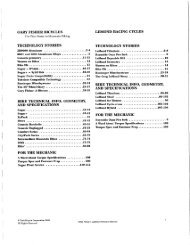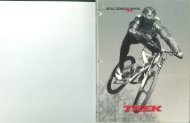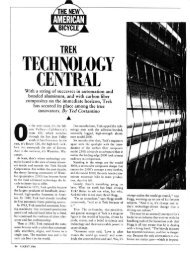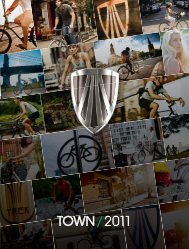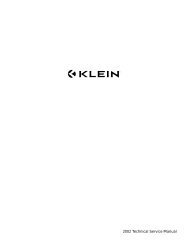TECHNOLOGY STORIES BIKE INFO, GEOMETRY ... - Vintage Trek
TECHNOLOGY STORIES BIKE INFO, GEOMETRY ... - Vintage Trek
TECHNOLOGY STORIES BIKE INFO, GEOMETRY ... - Vintage Trek
Create successful ePaper yourself
Turn your PDF publications into a flip-book with our unique Google optimized e-Paper software.
Kids’<br />
114<br />
For 2002<br />
These frames remain unchanged from 2000.<br />
Geometry<br />
Our Kids’ bikes are designed to satisfy both kids and<br />
their parents. By carefully designing the frame and<br />
components, we make the bikes easier for kids to get on<br />
and ride. At the same time, we make the bikes provide a<br />
wide range of fit so kids can get on a model early, and<br />
enjoy it longer as they grow.<br />
Ride<br />
Within the normal limits of parts availability, we’ve<br />
looked at keeping the pedals close together. We use size<br />
specific crank lengths, bar widths, and saddle sizing. We<br />
keep the bottom brackets as low as possible for easy<br />
on and off, as well as a low center of gravity. When we<br />
spec a hand brake, we also make sure that fits. With<br />
our attention to these details, <strong>Trek</strong> kids bikes are bikes<br />
easier to learn on, and more fun to ride.<br />
Frame details<br />
Our frame details will likely be lost on the kids. But<br />
the parents will be concerned with durability and cost.<br />
These bikes aren’t really about a technical dissertation,<br />
so we don’t even include frame geometry here.<br />
The important difference here is that our Kids’ bikes<br />
go through the full <strong>Trek</strong> testing regimen. Passing this<br />
rigorous evaluation means they’re designed and built to<br />
last.<br />
For the rest of the bike, we’ve focused on providing<br />
the best ride for the cost. By carefully designing the<br />
frame geometry and tubing, and carefully selecting the<br />
components, we’ve managed to get a lot of ride from a<br />
bike that will still pass our testing requirements. This<br />
allows riders a viable high quality alternative to chain<br />
store bikes which don’t ride or last nearly as well. These<br />
are bikes that can be handed down from kid to kid as<br />
a family grows, and which will promote cycling because<br />
they make riding more fun.<br />
Extra attention to specs on kids’ bikes.<br />
To an experienced cyclist, many of the details of our<br />
Kids’ bikes may seem humdrum or at best ‘normal’.<br />
There-in lies a key to our <strong>Trek</strong> kids’ bikes; they use<br />
parts you’d expect on other <strong>Trek</strong> bikes. While other<br />
brands may use plastic bushings, we use real, round<br />
steel ball bearings because the parts will run smoother<br />
and last longer. Even on our 12” wheeled models. On<br />
bikes where we spec training wheels, they are massively<br />
overbuilt, because we know your toddler is depending<br />
on them. We use 4 bolt stems, for extra handlebar security<br />
(parents, just how often do you thoroughly check<br />
your kids’ bikes?). Our saddles use adjustable seatpost<br />
clamps, offering both fore/aft adjustment and tilt. Just<br />
like on an adult bike, this allows proper positioning<br />
and comfort for your child. Many of our competitors<br />
forego these simple details. We use size specific cranks,<br />
handlebars, pedals, and even saddles. For bikes with<br />
hand brakes, we’ve found better fitting levers, so your<br />
child can comfortably apply all the stopping power they<br />
need. All this attention costs a bit more, but we think<br />
your child will be more comfortable, safer, and learn<br />
faster on a <strong>Trek</strong> bike.<br />
2002 <strong>Trek</strong> Technical Manual




